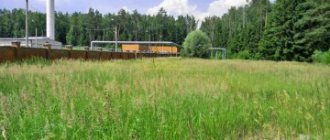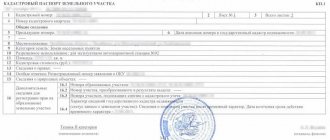Land is one of the most valuable resources of the state, therefore its use must be rational, safe, and planned. To comply with such requirements, all land areas are divided into certain categories, according to which the intended purpose of the land plot is determined.
When exploiting the land area, not only the characteristics of the category are taken into account, but also the types of permitted use.
- 1 Types of intended use
- 2 Requirements
- 3 Features
- 4 Specially protected areas
- 5 Forest fund
- 6 Industrial lands
- 7 Permitted use
- 8 Violations and liability
- 9 Law
It is important for legal entities and individuals who own land to have an understanding of these concepts (category, VIR, intended purpose), since using the land for other purposes is a serious offense.
Features of the intended purpose
The Land Code identifies the following categories of plots:
- Settlements;
- for carrying out agricultural activities;
- forest fund;
- territories related to the water fund;
- industrial territories (areas with production enterprises located on them, facilities in the defense, energy and other spheres);
- land with a special purpose;
- territories to be protected;
- reserve lands.
Misuse of land of any category entails administrative liability. Therefore, before buying a plot for certain needs, it is important to first find out whether a certain activity is permissible here.
Register of targeted land use Source agroexpert.md
How to find out which category of land a particular plot belongs to and what it can be used for? Such data can be obtained from the cadastral service. VIR will also help you decide on the selection of suitable land. All information about the sites with their codes and destination options is collected here.
Definition of concepts
In the provisions of Article 7 of the Land Code of the Russian Federation, the legal regime of a land plot is established on the basis of membership in a particular group and status for exploitation. Order of the Ministry of Economic Development of the Russian Federation No. 540 precisely defines the names of the categories of permitted use and the options according to which the use of land is possible.
Since the beginning of 2015, all such types are considered and approved only by the Classifier. Before this, such power could also be exercised by local governments. But as a result of their activities, there was a significant expansion of options for the content of legal regimes in relation to land, which led to the emergence of inaccuracies and confusion.
Article 7. Composition of lands in the Russian Federation
Requirements for the use of agricultural land
Land classification is used to ensure that its owner understands how he can use it and does so as carefully and rationally as possible. This makes it possible to plan the development of territories to save those where activities are already underway. On agricultural plots it is allowed:
- grow any agricultural crops;
- engage in livestock farming activities;
- grow fruit bushes and trees;
- arrange apiaries;
- build facilities that may be required for agriculture, product processing and subsequent storage;
- create artificial reservoirs for the purpose of breeding fish;
- allocate areas for grazing livestock or growing grass for them;
- run a dacha farm.
The intended use of agricultural land does not imply the construction of residential premises (with the exception of country houses) or industrial buildings (with the exception of processing of grown products). To conduct any other activity here other than agriculture, you must first transfer the site to another, suitable category.
Registration of a land plot for intended use Source economy.24tv.ua
To carry out such a transfer, it is necessary to conduct a state examination. She must confirm the fact that it is impossible to use the land for agricultural needs. If there is a need to build a private house here, then based on the classifier, they choose the option intended for individual housing construction.
conclusions
The type of permitted change in land area is determined by the relevant authorities; they also make adjustments if necessary to make changes to the type of use of the territory and buildings on it. At the same time, the possibility of implementing such a change that affects the interests of society is taken into account.
To obtain a change, it is important to carefully prepare the documentation, take into account the specifics of the future use of the area, correctly fill out the declaration and application, and attach a list of documents and copies to the package.
Types of permitted land use are discussed in detail in this video:
Didn't find the answer to your question? Find out how to solve exactly your problem - call right now: +7 for free!
Settlements and features of these lands
This includes lands on which any types of settlements are located (towns, villages, towns, hamlets, hamlets). These areas are divided by zoning and type of permitted use. In any settlement, in addition to the residential area, administrative and other buildings, industrial facilities, and public areas can be located.
When using the land of a settlement, it is important to adhere to those types of activities that are permissible on a particular site. This is due to the fact that any activity carried out should not harm the environment or the residents of this locality.
Targeted use of agricultural land Source vesti-k.ru
Lease of land, Civil Code of the Russian Federation: what is the object?
According to the Civil Code of the Russian Federation, the object of the lease agreement is land. Provided that buildings located on the territory are also rented out along with it, this is also indicated in the agreement:
- House.
- Natural object.
- Commercial building.
- Ancillary buildings.
- Garages.
- Communication objects.
- Small ponds.
The purposes and nature of use must be indicated - how the tenant will operate the plot and the objects located on it:
- Conduct personal farming.
- Live in a residential building for a certain period of time.
- Raise animals, do gardening.
- Use commercial premises for production and other types of business activities.
For each object, the name, characteristics and features are specified in the contract.
The following areas cannot be rented:
- Reserves and other environmental sites.
- Territory owned by the Federal Security Service.
- The land where military exercises and tests are conducted.
- Areas where radioactive waste is stored.
What applies to specially protected areas
Specially protected land refers to those areas that have cultural, natural, recreational or other value. Here, for example, there may be a national park or reserve, an area with a special microclimate, or an object with a unique landscape.
Why was this category selected? This is necessary to protect unique territories and their qualities. The intended use of these lands does not allow any construction on them. The only thing that is acceptable is the implementation of environmental protection measures.
Assessment of land resources and determination of their intended use Source anapa.media
These lands have a special legal status. Therefore, when a violation of their intended use is revealed, administrative or even criminal liability is applied to the violator. Special purpose areas include:
- recreational areas;
- territories where there are objects of cultural or historical heritage;
- protected areas;
- areas marked with special protection status.
Conducting any kind of farming here is prohibited by law.
Coronavirus subsidies in the simplified taxation system declaration
Section 3 is filled out by taxpayers who received targeted financing, targeted revenues and other income from clauses 1 and 2 of Art. 251 of the Tax Code of the Russian Federation (Order of the Federal Tax Service dated February 26, 2016 No. ММВ-7-3 / [email protected] ).
Therefore, we include only non-taxable income. Only subsidies paid on the basis of Government Decree No. 576 dated April 24, 2020 are exempt from taxation under paragraphs. 60 clause 1 art. 251 of the Tax Code of the Russian Federation (letter of the Ministry of Finance dated September 2, 2020 No. 03-03-06/1/76953). They should be indicated in section 3 of the simplified taxation system declaration, since they are not taxable.
The subsidy for disinfection and prevention of coronavirus according to Resolution No. 976 is paid to taxpayers of a different category, so the norm is paragraphs. 60 clause 1 art. 251 of the Tax Code of the Russian Federation does not apply. This subsidy is included in income in the general manner at the time of receipt to the current account (by virtue of clause 1 of Article 346.17 of the Tax Code of the Russian Federation). Expenses at her expense are also reflected in the usual manner (clause 2 of Article 346.17 of the Tax Code of the Russian Federation).
Get advice from experts of the reference and legal system Standard
Features of forest areas
The forest fund refers to those lands with plantations where forestry is permitted. Logging or wood processing enterprises can also be built in areas that do not have forest fund status.
On what category of land is the construction of residential buildings allowed? Source zillow.com
Types of permitted use
This includes concepts that clarify the rules of land law. According to them, all areas, based on their use, are divided into:
- Basic. These include lands that can be used directly for the purposes specified in the category to which they are classified. For example, on agricultural lands it is allowed to graze livestock, plant any crops or build farms. The land of the settlement is suitable for the construction of residential buildings.
- Conditionally permitted. This type of land use involves the creation of a list of sites allowed for use in cases where it is intended to expand the methods of operating existing facilities and this does not contradict the law.
- Auxiliary. This type of land use involves their involvement only when it is necessary for the normal functioning of territories that already exist.
Cadastral passport of a land plot Source kadastrmap.com
Accounting
TF funds are accounted for on the liability side of account 86 with the appropriate name. There is an accounting instruction according to which account 86 serves to summarize data on the movement of money that was received from the state. Money received for the implementation of projects is recorded in correspondence with account 76. When using money or property, correspondence with accounts 20 and 26 is used. The last account is used by non-profit organizations.
The credit flip of account 86 records unused funds. Credit turnover indicates targeted receipts, debit turnover indicates the use of funds. Let's consider the basic operations associated with targeted financing:
- DT86 KT08. Directing money to purchase fixed assets and intangible assets.
- DT86 KT10. Directing money to purchase tangible assets.
- DT86 KT70. Directing money to pay salaries.
- DT86 KT60. Directing funds to pay off debts to suppliers.
- DT86 KT51.76. Refund of money that was not spent.
- DT51 KT86. Receiving funds from the state.
- DT76 KT86. Obtaining funds from budget financing.
- DT60.76 KT51. Use of funds received free of charge to cover current expenses.
- DT86 KT98-2. Reflection of funds received free of charge.
It is recommended that the accountant create 2 sub-accounts:
- 86.1. Receiving money from budget sources.
- 86.2. Receiving money from other sources.
It is also important to correctly maintain analytical accounting of financial assets. It is necessary to indicate the source of funds, the purposes for which they will be directed, and the conditions for receiving the money. It is required to register the amount of income for each type of financial fund, as well as the balances of funds received.
Examples
The production structure received funds from the state free of charge for the purchase of equipment. The following entries are reflected in the accounting:
- DT60 KT51. Payment of fixed assets. The money is sent to the supplier.
- DT08-4 KT60. Receipt of OS for production.
- DT01 KT08-4. The OS has been put into operation.
- DT86 KT98-2. Reflection of the target direction of money as part of the income of the following periods.
- DT20, 23, 25-26, 29.44 KT02. Depreciation calculation.
- DT98-2 KT91-1. Inclusion of income from the following periods in the amount of calculated depreciation into other income.
Let's look at another example with an NPO. The non-profit entity received funds to organize a charity event. The following wiring will be used:
- DT20 KT60.76. A charity event was held using public funds.
- DT20, 26 KT10. Consumption of materials.
- DT20.26 KT70, 69. Calculation of salaries and insurance contributions.
- DT60, 76 KT51. Payment for the services of the performer, contractor, supplier.
- DT69 KT51. Direction of insurance premiums to funds.
- DT70 KT50. Issuance of salary.
- DT86 KT20, 26. Expenses are written off from the funds of the Central Fund.
The last entry is used only after current expenses have been paid. For each transaction, you need to reflect the exact amount of the transaction, as well as primary documents.
Misuse of land
Some owners of land plots believe that having a document of ownership in their hands, they are able to dispose of this territory at their own discretion. But that's not true. Therefore, various violations of the law often arise. According to the Land Code, only the type of activity that is prescribed by a certain category can be carried out on a site.
The targeted use of land is aimed at maintaining balance in the environment and creating comfortable conditions for the population.
You will be able to purchase only the plot that belongs to the lands of a populated area, industrial or agricultural purpose. The rest (forest fund, reserve or special purpose land) belongs to the state or can be transferred for use to municipalities.
Misuse of land Source mfc-list.info
Misuse of an allotment is expressed in the conduct of activities on its territory that are not provided for by law, in particular the Land Code. Revealing the fact of such activity entails administrative liability. This could be a fine, termination of the right to use a given site, or seizure of land. Eg:
- The owner of the land used the site contrary to its intended purpose. For such a violation you must pay a fine. The amount of the fine is determined based on the cadastral price of the site. On average, an individual can be fined over 10,000 rubles. If an official is involved in the violation, the amount can reach up to 100,000 rubles.
- If the land was purchased for the construction of a residential building, but subsequently the house is not built, and the plot is simply empty and littered, the owner risks receiving a fine, the amount of which is not less than 400,000 rubles.
Checking the intended use of the land Source mykolaivska.land.gov.ua
Nuances of receiving
There are two ways to obtain a land plot: paid and free. The basis for its transfer to the ownership of citizens is a resolution issued by local authorities. Anyone, regardless of legal and social status, can purchase land.
The condition for its provision is the free status of the land plot. In particular, it should not be limited in circulation or withdrawn from it. An application for the provision of a site is submitted to the local administration. The authorities make the decision.
If there is no ban on the provision of land, then you can obtain it as follows:
- holding auctions;
- privatization of leased territory, which has been registered with Rosreestr;
- obtaining a plot that does not have an owner.
The most common option is to lease land. The owner at the initial stage is the local government authority. The land must be used for its intended purpose. If it is not used by anyone for 5 years, even if the tenant pays rent, the state can take away the land and terminate the contract.
When purchasing a plot, you should be aware that the legislator sets area restrictions. For example, plots of no more than 15 acres can be transferred for individual housing construction in Russia. For a vegetable garden, farming, as well as arranging a summer house - 25 acres.
If the lease is subject to re-registration of the tenant's ownership, then all these procedures are carried out for a fee. The state requires that the costs be borne by the person who initiates the acquisition of the plot of land. For him, the acquisition of a land plot means that he, on a voluntary basis, assumes responsibilities related to the maintenance of the land and the payment of land tax on it.
How to avoid penalties?
The most common type of punishment when it is discovered that a site is being used contrary to its intended purpose is a fine. To avoid punishment, the land owner must:
- use the land exclusively for its intended purpose, if necessary, promptly transfer it to another more suitable category;
- during the operation of the site, avoid actions that may cause harm to the environment;
- If no activity is carried out on agricultural land, it is necessary to mow the grass at least once every 3 years.
There does not need to be a court decision to impose a fine. The land inspector has the right to write it out. As for the court, people come here only with questions about the seizure of land.
Responsibility for misuse of land by its owner Source wallpaperhunt.net
Rosreestr
When changing the type of permitted use of a land plot, you must be guided by the land use and development rules for a specific municipality.
The main and auxiliary uses of the site can be changed independently without additional permits and approvals. To do this, you must contact the Rosreestr Office to enter information about changing the type of permitted use into the Unified State Register.
To change a conditionally permitted use, permission from the local government must be obtained. The head of the local administration makes a decision taking into account the results of public discussions or public hearings.
Information about the type of permitted use of the land plot is contained in the Unified State Register of Real Estate. This is an additional characteristic of the site.
Types of permitted use are divided into basic, conditionally permitted, and auxiliary. The procedure for changing the type of use depends on belonging to one of these categories.
The procedure for changing the type of permitted use of a land plot depends on whether land use and development rules have been approved for a given municipality.
Usually such rules are approved. They establish the boundaries of the territorial zone and contain urban planning regulations. In addition, from them you can find out the procedure for changing the type of permitted use. When changing the type of use, technical regulations must be observed.
To find out how to change the type of permitted use of a site in a given municipality, you need to clarify whether there are land use and development rules. The procedure for changing the type of use (in particular, the procedure, terms, list of documents) can be determined in the regional administrative regulations.
If there are no rules, check with the local administration how to change the type of permitted use of the site.
If urban planning regulations are not established for land, changing the type of permitted use of the site is carried out differently.
It may be necessary, for example, to transfer land from one category to another.
The list of permitted uses for a given territorial zone can be found in the town planning regulations. They are established according to the classifier, which was approved by the Order of the Ministry of Economic Development of Russia dated September 1, 2014. No. 540.
The specified regulations may establish the type of permitted use, taking into account the characteristics of the territorial zone and provide for a combination of different types of use of the site.
If it is necessary to change the type of use to one not provided for by the town planning regulations, you will have to contact a special commission to amend the Land Use and Development Rules.
It is not possible to change the type of permitted use in the following cases;
- at the request of the tenant - if the lease agreement for a plot that is in state (municipal) ownership is concluded at auction;
- from the tenant independently - if the site is leased for a specific type of use;
- if the town planning regulations, Land Use and Development Rules for the requested type of use establish maximum dimensions and parameters that do not allow activities to be carried out in accordance with this type of permitted use.
To change the main and auxiliary types of permitted use, the owner must contact the Rosreestr Office to enter information about the change in the type of permitted use into the Unified State Register.
The copyright holder (except, for example, government bodies, state unitary enterprises and municipal unitary enterprises) can independently choose the main and auxiliary type of permitted use from those established by urban zoning.
Thus, you do not need to obtain the consent of the local government if the site is privately owned and located in an area for which land use and development rules have been approved.
An auxiliary view can only be selected in addition to the main and conditionally permitted one. You cannot install it instead of the main one.
To change a conditionally permitted type of use, you must obtain permission for a new conditionally permitted type of use of the land plot.
To do this, an interested person (for example, a tenant) must submit an application to the authorized body of the municipality, for example, to the commission for the preparation of rules for land use and development of the municipality.
In some municipalities this can be done through the MFC or on the government services portal.
The application form is given in the regional administrative regulations for the provision of this service. It can also be found on the government services portal or on the MFC website.
The list of documents that should be attached to the application is also established by the regulations. For example, the consent of the owner of the site may be required to change the type of permitted use.
The decision to grant permission for a conditionally permitted use is made by the head of the local administration, usually based on the results of public discussions or public hearings.
Sources
- Galkin Vladimir Peculiarities of criminal liability and punishment of minors; KnoRus - M., 1985. - 652 p.
- Petrova, G.V. Tax law / G.V. Petrova. - M.: Norma, 1999. - 271 p.
- Legal regulation of the activities of organizations providing services in the field of healthcare, education and culture; Jurisprudence - M., 2013. - 633 p.
- Minto The Golden Rules of Harvard and McKinsey. Magic Pyramid Rules for Business Writing / Minto, Barbara. - M.: Rosman, 2004. - 192 p.
- Omelchenko, O. History of political and legal doctrines. History of doctrines about state and law / O. Omelchenko. - M.: Eksmo, 2006. - 576 p.
Prosecution
Special bodies are responsible for the protection of land and the procedure for its use. If they have identified the fact of misuse of land, they act according to the following scheme:
- The fact of violation is revealed. This may happen during the audit.
- The inspector sends a request to the violator to cease actions that violate the law.
- An administrative protocol is drawn up.
- The case is considered by an authorized body or in court. After consideration, a decision is made to impose a fine.
- If the violation is not corrected, a notice is sent to the land owner stating that the site will be repossessed.
If the owner agrees to the notice, a public auction is held. If he is against this, then a forced seizure is carried out. The case is being considered by the court.
Fine for misuse of land Source bryansknovosti.ru
How to reflect loans and subsidies in KUDiR with a simplified tax system of 15%
We tell you how to indicate the amounts of an interest-free loan and coronavirus subsidies in the book of income and expenses for the simplified tax system.
Subsidy for victims (Government Decree No. 576 dated April 24, 2020)
The tax base under the simplified tax system does not take into account the income specified in Art. 251 of the Tax Code of the Russian Federation (clause 1, clause 1.1, article 346.15 of the Tax Code of the Russian Federation). Subsidies received under Decree of the Government of the Russian Federation dated April 24, 2020 No. 576 (letter of the Ministry of Finance dated September 2, 2020 No. 03-03-06/1/76953) were also included in the list of income exempt from taxation.
Organizations using the simplified tax system do not take into account the subsidy in their income and the costs incurred at its expense in their expenses. For example, payment of salaries, insurance premiums, interest on borrowed funds, etc. If the company accepts such expenses for tax purposes, then the amount of the subsidy in this part will have to be included in income (letter of the Ministry of Finance of Russia dated June 25, 2020 No. 03-03-05/54635).
Subsidy for disinfection according to Government Decree No. 976 dated 07/02/2020
Under the simplified tax system, the subsidy for disinfection is taken into account in income on the date of crediting to the organization’s current account. The exemption provided for in paragraphs. 60 clause 1 art. 251 of the Tax Code of the Russian Federation does not apply to it (letter of the Ministry of Finance of Russia dated March 10, 2020 No. 03-03-07/17264, Federal Tax Service of Russia dated February 27, 2019 No. SD-4-3/3427).
Expenses from subsidy funds are recognized for tax purposes under the simplified tax system on the basis of paragraphs. 39 clause 1 art. 346.16 Tax Code of the Russian Federation.
In KUDiR the amount of the subsidy is reflected as follows:
- the amount of the subsidy is indicated in income in column 4 upon receipt to the current account;
- expenses due to the subsidy are indicated in column 5 in the usual manner after payment.
Preferential loan at 2% per annum
Loans for resumption of activities are issued according to the rules approved by Government Decree No. 696 dated May 16, 2020.
The amount of the loan received with state support at 2% per annum is not reflected in the KUDiR. Borrowed funds do not affect the amount of tax payable under the simplified tax system, since they are not included in either the income or expenses of the taxpayer (clause 1 of Article 346.15 of the Tax Code of the Russian Federation, clause 10 of clause 1 of Article 251 of the Tax Code of the Russian Federation, clause 1 of Art. 346.16 Tax Code of the Russian Federation, Letter of the Federal Tax Service of the Russian Federation dated May 19, 2010 No. ШС-37-3/1925).
If all the conditions for writing off the loan are met, the “forgiven” amount is also not taken into account in income under the simplified tax system (clause 21.4 of article 251 of the Tax Code of the Russian Federation), and therefore is not indicated in the KUDiR.








